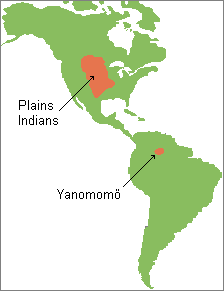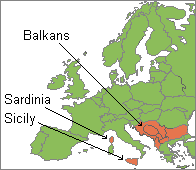Warfare
Armed conflict is common among humans. It
occurs both between and within societies. Many behavioral scientists
are convinced that people are by nature aggressive animals. From this
perspective, fighting is natural for us. The majority of other primate
species are relatively peaceful. Among the primates, it may only be humans and
chimpanzees (our nearest living relatives) who carry out
genocide. Violent
physical fighting is primarily a male activity among humans and chimpanzees.
Adult male chimpanzees also spend much of their waking time involved in
politics. They intimidate, scheme, and form short-term
alliances with other males to be able to move up the dominance
hierarchy. The rewards are the same as for human politicians--gaining
more access to what their society values, whether it be food, sex, land, or
simply control over others.
A comparison of the variations of fighting in different kinds of human societies around the world shows that it does not always take the form of what we commonly think of as warfare. It is useful in understanding armed conflict to divide it into three categories--feuding, raiding, and warfare. However, it is important to keep in mind that they are not always clearly distinct in every society.
Feuding
Feuding is prolonged hostility and occasional physical fighting between individuals and their supporters rather than whole societies. It is a universal form of human aggression that mostly occurs between members of the same society, though it can occur between people from separate societies as well. It is caused by a desire for revenge for a perceived prior wrong. Usually, both sides in feuds believe that they have been wronged and seek to settle the score. Inherent in feuds is a failure in communication between the feuding parties and the belief that there needs to be "an eye for an eye." Without adequate retribution, there is minimally a loss of face for the families involved. Sometimes the need for retribution involves more than just the living. Among the Dani people of Papua New Guinea, the spirit of a person killed in a feud will not rest until he or she is revenged by living relatives killing someone in the enemy group.
|
|
|
Regions of Europe
where |
In many societies, feuding results in an endless cycle of reciprocal killings. There are feuds between families in the Balkans, Corsica, and Sicily that have been going on for hundreds of years. "Vendetta" is now a common English word for a lasting blood feud of this sort. The word "vendetta" comes from 19th century Italian and ultimately the Latin word "vindicta" meaning "vengeance". Shakespeare's play "Romeo and Juliet" is the tragic story of young lovers from prominent families in Verona Italy who had a bitter blood feud between them. The most famous blood feud in North America was between the Hatfield and McCoy families along the Kentucky and West Virginia border. It began sometime in the 1870's or somewhat earlier. The original trigger apparently was a dispute over a pig. During the next several decades, dozens of people from both families were murdered. By the 1920's, police intervention had reduced the violence, but the Hatfield and McCoy families did not officially end their feud until 2003 when their descendants signed a formal peace agreement.
Raiding
 |
|
Raiding consists of surprise predatory attacks directed against other communities or societies. Revenge may or may not be a motive. The primary objective of raiding usually is to plunder and then to escape unharmed with the stolen goods. In some societies, the goal is also to kill men in the target community as well as kidnap women and children. Raiding is a more organized form of aggression than feuding. Violent encounters are often the result of opportunistic meetings in the case of feuding. In contrast, raids are planned in advance. Another difference is that raids occur in a finite time period. They are rarely sustained activities like feuds.
Raiding is common among pastoral societies, especially in East Africa. It is a quick and efficient way for young men to start a herd or add additional animals to a herd. It also has the benefit of keeping young men trained for protecting their family's' cattle. The horse riding bison hunting tribes of the North American Great Plains also regularly raided each other for essentially the same reasons. They stole horses, women, and children. In both the African cattle herding societies and the North American bison hunting ones, boys were encouraged to be brave and aggressive. They also gave high status to those men who succeeded in raids. Men in some small-scale farming societies, such as the Yanomam and other lowland forest people of South America, raided each other's settlements when population pressure forced competition for scarce resources. It is not surprising that these peoples also prized aggressive, violent behavior among men.
Warfare
The term warfare is used here to refer to a larger scale and more sustained form of fighting than feuding and raiding. It involves organized combat usually between clearly recognizable armies. A significant portion of a society's population takes part in combat or support activities, often for years. Soldiers are trained and equipped for combat.
Warfare as defined here is not universal. It mostly occurs between large-scale farming or industrial societies. They are the only kinds of societies that can afford to have large numbers of men not be involved in food production for prolonged periods of time. Warfare has been virtually absent among small-scale societies, especially pedestrian foragers. This may be due to two factors. They rarely have large enough surpluses to support soldiers who must train and fight rather than produce food. Most adult males are needed year round for subsistence activities. In addition, the population sizes of band and tribal level societies are generally too small to create armies. This does not mean that they are always peaceful and never fight with their neighbors. However, when they do fight, it is rare for there to be many fatalities. They usually cannot afford the loss of more than a few men. It would be too great an economic blow for the society. Subsequently, when casualties mount up, they often break off combat and go home. In contrast, large-scale agricultural societies with thousands or even millions of people essentially have surplus men who they can afford to lose without it seriously affecting their economies. The larger the population is, the more this holds true. Given these realities, it should not be a surprise that the first evidence of large-scale warfare was not until about 5,500-4,500 years ago when chiefdoms were growing in power and evolving into the first ancient states. As these states grew larger and more powerful through military conquests, they evolved into the well known early civilizations of Mesopotamia, Egypt, India, China, Mesoamerica, and Western South America.
The reasons why societies have gone to war are varied and often complex. Revenge has usually been a key factor. In many cases, there has been a desire to gain or control more land and other resources. At other times, the goal was simply the conquest or even outright destruction of another people. Many wars have been motivated by religious or political ideals. It is likely that all societies have gone to war believing that they were morally justified and that the gods were on their side. There is one final common trait found among early states that were beginning to wage wars of conquest against neighboring states. That was considerable population pressure and a growing scarcity of land, water, or other essential resources.
|
|
|
|
|
Modern large-scale mechanized warfare in Iraq |
||
This page was last updated on
Tuesday, July 11, 2006.
Copyright 2004-2006 by Dennis
O'Neil.
All rights reserved.
Illustration credits
